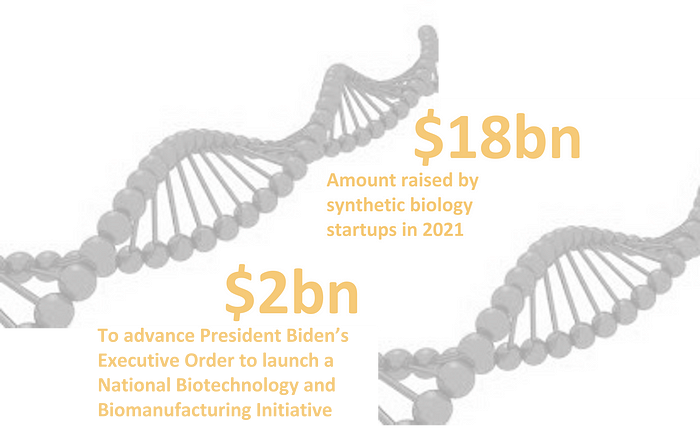Material Gowrl; Let’s Talk Biomanufactured Materials



Last month, the White House announced the launch of new biotechnology and biomanufacturing initiatives backed by $2b in funding. What is critical in this announcement is that about $1b will come from the Department of Defense to catalyze the establishment of domestic bio-industrial manufacturing as a form of national security. It has been an energizing time for biomanufacturing with rising institutional and governmental support.
Biomanufacturing covers many industries including pharmaceuticals, food and beverage, and chemicals but rising demand for renewable resources further drives its development. According to McKinsey, as much as 60% of physical raw inputs could be re-produced biologically. One-third of these are the more obvious biological materials (think meat and wood) but much of the remaining are “nonbiological” materials potentially substituted using biological processes (think plastics). While many of the use cases are a long way off, the sheer potential can create new origins for scarce resources like bluefin tuna or fuel.
Naturally, venture investment has grown as well, with synthetic biology startups raising nearly $18b in 2021. Most of these dollars have gone towards companies developing specific products, often in food and nutrition or health and medicine. One application where Flat World Partners has already invested is FoodTech (see our note on BlueNalu). Precision fermentation and cellular agriculture could be an important tool to help feed the growing global population a healthy and sustainable diet. By reducing our reliance on animal agriculture, precision fermentation and cultivated meat developers aim to lower the food system’s carbon footprint, cut land-use, and improve water stewardship.
Caution should be used, however, when evaluating many bio-alternatives when it comes to offsetting or reducing carbon. For a biomanufacturing process to be carbon negative, it must sequester more carbon than it emits over its entire lifetime. This narrows the range of products that can reasonably be deemed carbon reducing. Bio-alternative plastics and fuels, which for the most part would be removing carbon from the atmosphere and skip that whole dinosaur fossilization phase, are not permanent sinks. Building materials are potentially interesting carbon sinks, however, with large opportunities in bio-based timber and concrete.
In any case, one of the largest bottlenecks to the bioeconomy is the lack of biomanufacturing infrastructure, fit for purpose manufacturing, and alternative financing. Should this industry grow outside of pharma, these physical processes will be a crucial factor to move from innovation to scale. In the case of FoodTech, moving production out of pilot and to a commercial scale of 200,000 liters will require innovation on the equipment side. Leveraging economies of scale is critical to bring down unit costs to move novel alternative proteins towards price parity with their animal-based counterparts. Investment in this crucial piece of infrastructure in the key to unlocking many of the potential innovations that science has to offer.
Derek Brooks, Head of Venture



The Biden administration have ordered a government-wide action plan for biomanufacturing. Read the whole policy here: Executive Order on Advancing Biotechnology and Biomanufacturing Innovation for a Sustainable, Safe, and Secure American Bioeconomy

For those deeply interested in the future of meat, the Good Food Institute’s Cultivated Meat Research Tools Database compiles research tools, reagents, protocols, assays, service providers, and other data to support cultivated meat researchers in academia and industry.

Literature can be a vehicle to imagine the future. The Ministry for the Future: A Novel by sci-fi author Kim Stanley Robins, uses fictional eyewitness accounts to tell the story of how climate change will affect us all, but also provides a glimpse into possible solutions. The New Yorker reviews it with some fascinating context on the book and author.




This newsletter is intended solely for informational purposes, and should not be construed as investment/trading advice and are not meant to be a solicitation or recommendation to buy, sell, or hold any securities mentioned. Any reproduction or distribution of this document, in whole or in part, or the disclosure of its contents, without the prior written consent of Flat World Partners is prohibited
Thank you for subscribing to our newsletter. Our privacy policy is available at anytime for you to review in order to understand how we protect your personal identifiable information. By subscribing to the newsletter you have consented to our policy
Forwarded this message? Subscribe Here!
Copyright © 2022 Flat World Partners, All rights reserved.
